We were back in Dresden again. You can read about an earlier trip at this link:
trewin-news-dresden-may-2007. I won't go over the old topics . . . much. Here are just a couple of recent photos.
 |
|
Semperoper |
The Semperoper is one of the several buildings around the Theater Square that make Dresden such a beautiful city to stroll through. Others are the Zwinger (which houses the Gallery of Old Masters) and the Hofkirche.
 |
| Frauenkirche at dusk |
Another beautiful part of town is around the New Market Square (Neumarkt), where the Church of Our Lady (Frauenkirche) holds a prominent position.
 |
| Brühl's Terrace |
 |
| Academy of Fine Arts |
Finally, a stroll along Brühl's Terrace with its gardens and monuments overlooking the Elbe River never gets old. The three spires behind me are, from left to right, the 400-year-old Residential Palace, the Saxon Ständehaus and the Hofkirche.
 |
| Albertinum entrance |
At the east end is the Albertinum, which is also called the New Masters
Gallery. We spent a few hours here again, beginning with sculptures of
Klinger and moving on to the works of German Romanticism.
If you're surprised at the term "German Romanticism", you might be thinking of romanticism in the sense of sexual seduction. Here the meaning refers to the collection of German-speaking philosophers and artists who emphasized the individual's subjective interpretations. It was a reaction to Rationalism. German Romanticism includes the later works of Beethoven (after he broke with classical composition), Wagner's operas, the early stories from Goethe's and Schiller's Sturm-und-Drang period, and the philosophical idealism of Hegel (who broke with the philosophical rationalism of Kant). To romanticize something, according to the poet Novalis, is defined as follows: "To romanticize is nothing but a qualitative heightening. In this process the lower self becomes identified with a better self. (…) Insofar as I present the commonplace with significance, the ordinary with mystery, the familiar with the seemliness of the unfamiliar and the finite with the semblance of the infinite, I romanticize it." Friedrich Schlegel added that the essence of Early German Romanticism is that the commonplace and ordinary "should forever be becoming, and never be perfected", so striving and yearning are also common components of German Romanticism.
 |
| Cross in the Mountains |
The most prominent painter was Caspar David Friedrich. There are 14 of his works in the Albertinum, including The Cross in the Mountains.
Friedrich painted landscapes and seascapes. But the paintings are neither relaxing nor calming. Instead, the paintings cause introspection and feelings of transcendence or isolation in the vastness of the scene. Many of his paintings are allegories for the stages of life, or death and resurrection.
One of the ways in which Friedrich broke with classical painting is in his lack of depth of field. In the Cross in the Mountains, the large amount of detail in the rocks makes the viewer assume he is closer than the size of the trees would imply. The viewer has no sense of perspective, which results in a sense of floating.
Another way in which Friedrich broke with classical painting is that people in Friedrich's paintings often have their backs to the viewer,
and are looking in the direction of the focal point. The viewer can't see
the expressions on their faces. In the Cross in the Mountains, the crucified figure is looking toward the sun.
There is a lot of symbolism in the painting. The evergreen
(ever-green) trees symbolize immortality and hope. Cross in the
Mountains was painted during the occupation of Germany by Napoleon, so
the evergreen trees could represent hope in liberation of Germany from
the French. The Christ figure could also represent the resurrection of
Germany after occupation by Napoleon.
 |
| Two Men Contemplating the Moon |
The lack of a depth of field and people with their backs to the viewer are also present in Two Men Contemplating the Moon, which is also full of symbolism. It was also
painted during the occupation of Germany by Napoleon, and the clothes on
the men are a style of medieval clothes that the anti-Napoleon
university students in Germany wore to promote nationalism. The old,
dead and gnarled oak tree could represent Germany under occupation. (See my blog on
Germans and their trees) The
waxing moon could symbolize hope.
 |
| The Grosse Gehege |
One of Kathy's favorite paintings is The Grosse Gehege (Big Game Refuge). Here we see another typical element in Friedrich's paintings: his use of geometry. Many of his paintings are composed of horizontal lines with a few vertical lines. Geometry can represent the perfection in mathematics. In The Grosse Gehege we see a horizontal line in the middle with two hyperbolas; one above and one below. There is a small sailboat near the point where the two hyperbolas meet. Boats in Friederich's painting often represent life's journey on the waters of time. The boat in this painting might be anchored on the far shore, which could represent the end of life.
I've added a few more of Friederich's paintings that we saw in the Albertinum. I'm ready to go back.













1 comment:
Wow Ricjard, never read Friedrich David explained in such clear simple terms! Yes - his is very unsettling. My favourite one is the man with his crutchesnext to him in a snowy landscape. BTW: Is german melancholy a part of german romanticism?
Post a Comment